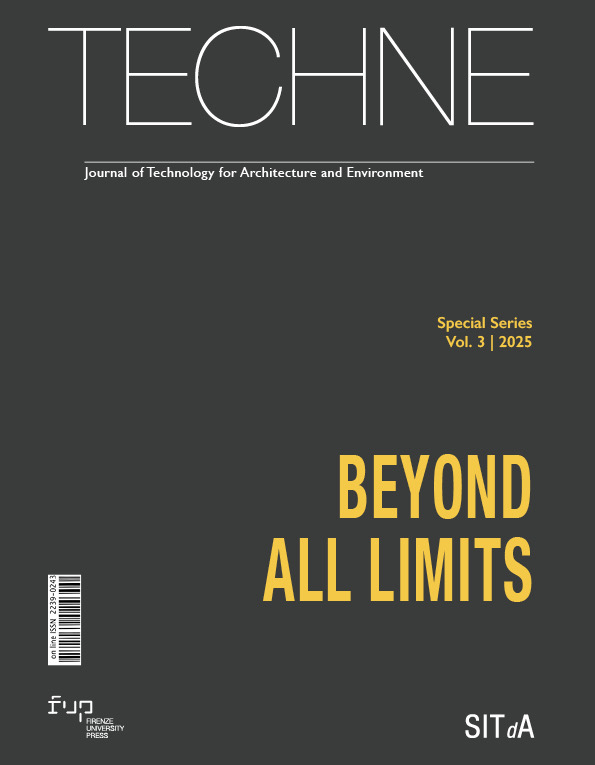Published 2025-07-31
Keywords
- University building,
- Cross-border living-lab,
- Energy retrofit,
- Human-environment centred design,
- Perceived comfort
How to Cite
Copyright (c) 2025 Antonella Violano, Monica Cannaviello, Souha Ferchichi, Ines Khalifa, Jose Luis Molina, Imad Ibrik, Antonella Trombadore

This work is licensed under a Creative Commons Attribution 4.0 International License.
Abstract
Sustainable building management requires creative interpretation of direct user needs, a skilful balance between technological innovation and applied research into the concept of “Possible Quality”. Med-EcoSuRe research project proposes a pragmatic approach to innovation, whereby experimentation involving the active engagement of end users is conducted with particular focus on human-environment centred design. The objective of this approach is to disseminate effective energy efficiency strategies in university buildings through a cross-border Living Lab. Physical and virtual tools were implemented to foster dialogue and collaboration between academics, decision-makers and stakeholders, and to support university energy managers in planning and implementing innovative energy measures. This paper, starting from a rapid illustration of the results of the research project, illustrates the value enhancing actions post-closure of the project, in progress and/or planned.
Downloads
References
- Ahmed, A., Mateo-Garcia, M., Arewa, A., and Caratella, K. (2021), “Integrated Performance Optimization of Higher Education Buildings Using Low-Energy Renovation Process and User Engagement”, Energies, Vol. 14(5), 1475, available at: https://doi.org/10.3390/en14051475 DOI: https://doi.org/10.3390/en14051475
- Ballon, P. and Schuurman, D. (2015), “Living labs: concepts, tools and cases”, info, Vol. 17, No. 4, available at: https://doi.org/10.1108/info-04-2015-0024 DOI: https://doi.org/10.1108/info-04-2015-0024
- Calcagno, G., Montoni, L., Olano, J.C. and Pierucci, G. (2023), “Building Digital Scenarios to Predict Energy-Efficient Renovations: The Experience of beXLab”, in Sayigh, A. (Eds.) Mediterranean Architecture and the Green-Digital Transition. Innovative Renewable Energy, Springer, Cham, available at: https://doi.org/10.1007/978-3-031-33148-0_51 DOI: https://doi.org/10.1007/978-3-031-33148-0_51
- Clausen, A., Arendt, K., Johansen, A., Sangogboye, F.C., Kjærgaard, M.B., Veje, C.T. and Jørgensen, B.N. 2021, “A digital twin framework for improving energy efficiency and occupant comfort in public and commercial buildings”, Energy Informatics, vol. 4, no. Suppl. 2, 40, available at: https://doi.org/10.1186/s42162-021-00153-9. DOI: https://doi.org/10.1186/s42162-021-00153-9
- Crespo Sánchez, E., Cornadó Bardón, C. and Paris Viviana, O. (2023), “Architectural and environmental strategies towards a cost optimal deep energy retrofit for mediterranean public high schools”, Energy Reports, Vol. 9, 2023, available at: https://doi.org/10.1016/j.egyr.2023.05.265 DOI: https://doi.org/10.1016/j.egyr.2023.05.265
- Evans, J., Jones, R., Karvonen, A., Millard, l. and Wendler, J. (2015), “Living labs and co-production: university campuses as platforms for sustainability science”, Current Opinion in Environmental Sustainability, Vol 16, pp. 1-6, available at: https://doi.org/10.1016/j.cosust.2015.06.005 DOI: https://doi.org/10.1016/j.cosust.2015.06.005
- Fuentes-del-Burgo, J., Navarro-Astor, E., Ramos, N.M.M. and Martins, J.P. (2021), “Exploring the Critical Barriers to the Implementation of Renewable Technologies in Existing University Buildings”, Sustainability, 13, 12662, available at: https://doi.org/10.3390/su132212662 DOI: https://doi.org/10.3390/su132212662
- Hu, M. (2018), “Optimal Renovation Strategies for Education Buildings—A Novel BIM–BPM–BEM Framework”, Sustainability, 10 (9), 3287, available at: https://doi.org/10.3390/su10093287 DOI: https://doi.org/10.3390/su10093287
- Kamari, A., Jensen, S. R., Corrao, R. And Kirkegaard, P. H. (2019), “A holistic multi-methodology for sustainable renovation”, International Journal of Strategic Property Management, Vol. 23(1), pp.50-64, available at: https://doi.org/10.3846/ijspm.2019.6375 DOI: https://doi.org/10.3846/ijspm.2019.6375
- Karrer, F. (2022), “Buildings, city and territory between real complexity and decision-making reductivism”, TECHNE – Journal of Technology for Architecture and Environment, Vol. 23, pp. 21–25, available at: https://doi.org/10.36253/techne-12916 DOI: https://doi.org/10.36253/techne-12916
- Longoria, L., López-Forniés, I., Sáenz, D. and Sierra-Pérez, J. (2021), “Promoting sustainable consumption in Higher Education Institutions through integrative co-creative processes involving relevant stakeholders”, Sustainable Production and Consumption, Vol. 28, pp. 445-458, available at: https://doi.org/10.1016/j.spc.2021.06.009 DOI: https://doi.org/10.1016/j.spc.2021.06.009
- Nansen, C. (2024), “Active Learning, Living Laboratories, Student Empowerment, and Urban Sustainability”, Sustainability, 2024, Vol. 16(10):3902, available at: https://doi.org/10.3390/su16103902 DOI: https://doi.org/10.3390/su16103902
- Österreicher, D. (2018), “A Methodology for Integrated Refurbishment Actions in School Buildings”, Buildings, Vol. 8(3), 42, available at: https://doi.org/10.3390/buildings8030042 DOI: https://doi.org/10.3390/buildings8030042
- Quevedo,T.C., Geraldi, M.S., Melo, A.P. and Lamberts, R. (2024), “Benchmarking energy consumption in universities: A review”, Journal of Building Engineering, Vol. 82, 2024, 108185, available at: https://doi.org/10.1016/j.jobe.2023.108185 DOI: https://doi.org/10.1016/j.jobe.2023.108185
- Sánchez, J., Guerrero, M.C., Álvarez, S., Molina, J.L., Sánchez, F.J. and Tenorio J.A. (2019), “Systematic Simplified Simulation Methodology for Deep Energy Retrofitting Towards Nze Targets Using Life Cycle Energy Assessment”, Energies, Vol. 12(16), 3038, available at: https://doi.org/10.3390/en12163038 DOI: https://doi.org/10.3390/en12163038
- Shahzad, M., Shafiq, M. T., Douglas, D. and Kassem, M. (2022), “Digital Twins in Built Environments: An Investigation of the Characteristics, Applications, and Challenges”, Buildings, Vol. 12(2), 120, available at: https://doi.org/10.3390/buildings12020120 DOI: https://doi.org/10.3390/buildings12020120
- Torricelli, M. C. (2017), “Technological culture, theories and practice in architectural design”, TECHNE – Journal of Technology for Architecture and Environment, vol. 13, pp. 21-26, available at: https://doi.org/10.13128/Techne-21128
- Trombadore, A., Montoni, L., Pierucci, G. and Calcagno, G. (2023), “Co-design Eco-Sustainable and Innovative Retrofit Scenarios in the University Context: The Experience of Bexlab”, in Sayigh, A. (Eds.), Mediterranean Architecture and the Green-Digital Transition. Innovative Renewable Energy, Springer, Cham, https://doi.org/10.1007/978-3-031-33148-0_50 DOI: https://doi.org/10.1007/978-3-031-33148-0_50
- Rinaldi, S., Bellagente, P., Ciribini, A. L. C., Tagliabue, L. C., Poli, T., Mainini, A. G., Speroni, A., Blanco Cadena, J. D. and Lupica Spagnolo, S. (2020) “A Cognitive-Driven Building Renovation for Improving Energy Efficiency: The Experience of the ELISIR Project”, Electronics, vol. 9(4), 666, available at: https://doi.org/10.3390/electronics9040666 DOI: https://doi.org/10.3390/electronics9040666
- Violano, A., Ibrik, I., Cannaviello, M. (2021), “Human-Centred Design: participated energy retrofit for educational buildings”, SUSTAINABLE MEDITERRANEAN CONSTRUCTION Journal, vol. 13/2021, p. 106-116, available at: https://doi.org/10.69148/SMC-2021-13-106






